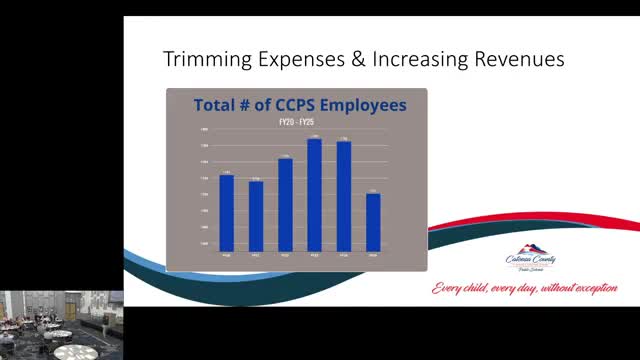School District Plans Shift to Third Party for Classified Positions Amid Rising Costs
March 29, 2025 | Catoosa County, School Districts, Georgia
This article was created by AI summarizing key points discussed. AI makes mistakes, so for full details and context, please refer to the video of the full meeting. Please report any errors so we can fix them. Report an error »

In a recent government meeting held in Georgia, discussions centered around the financial challenges facing local schools as they navigate the aftermath of COVID-19. A key point raised was the impact of federal funding, specifically the Elementary and Secondary School Emergency Relief (ESSER) funds, which were utilized to hire academic interventionists and custodial staff during the pandemic. These positions, funded by grants, are set to expire at the end of fiscal year 2024, leading to concerns about potential job losses and a decrease in support for students.
The meeting highlighted that while some districts used ESSER funds to offset regular expenses and build reserves, the local district prioritized direct support for students, resulting in a lack of financial cushion. This decision, while aimed at addressing immediate educational needs, has left the district facing a budget shortfall as federal funds dwindle.
To manage rising costs, particularly in employee benefits, the district is considering transitioning some classified positions to third-party management. This move aims to alleviate the financial burden of health benefits, which are projected to exceed $22,000 annually per employee. The district is exploring various methods for this transition, including attrition and voluntary participation, to ensure that employees retain their jobs while managing costs effectively.
Additionally, the meeting underscored the ongoing efforts by district leaders to explore new revenue streams and maximize existing funds. This includes consulting with experts and financial partners to enhance earnings from district funds and seeking additional grants that have not been historically pursued.
As the district grapples with these financial challenges, the focus remains on maintaining support for students and ensuring that educational standards are upheld in the community. The discussions from this meeting reflect a broader commitment to addressing the needs of local schools while navigating the complexities of funding and resource management in a post-pandemic landscape.
The meeting highlighted that while some districts used ESSER funds to offset regular expenses and build reserves, the local district prioritized direct support for students, resulting in a lack of financial cushion. This decision, while aimed at addressing immediate educational needs, has left the district facing a budget shortfall as federal funds dwindle.
To manage rising costs, particularly in employee benefits, the district is considering transitioning some classified positions to third-party management. This move aims to alleviate the financial burden of health benefits, which are projected to exceed $22,000 annually per employee. The district is exploring various methods for this transition, including attrition and voluntary participation, to ensure that employees retain their jobs while managing costs effectively.
Additionally, the meeting underscored the ongoing efforts by district leaders to explore new revenue streams and maximize existing funds. This includes consulting with experts and financial partners to enhance earnings from district funds and seeking additional grants that have not been historically pursued.
As the district grapples with these financial challenges, the focus remains on maintaining support for students and ensuring that educational standards are upheld in the community. The discussions from this meeting reflect a broader commitment to addressing the needs of local schools while navigating the complexities of funding and resource management in a post-pandemic landscape.
View full meeting
This article is based on a recent meeting—watch the full video and explore the complete transcript for deeper insights into the discussion.
View full meeting
